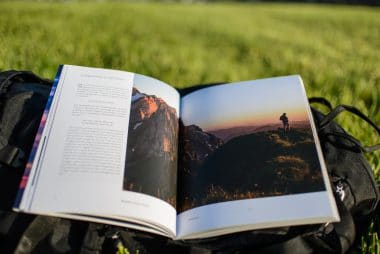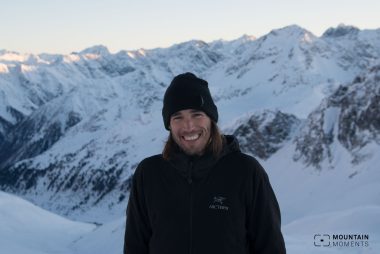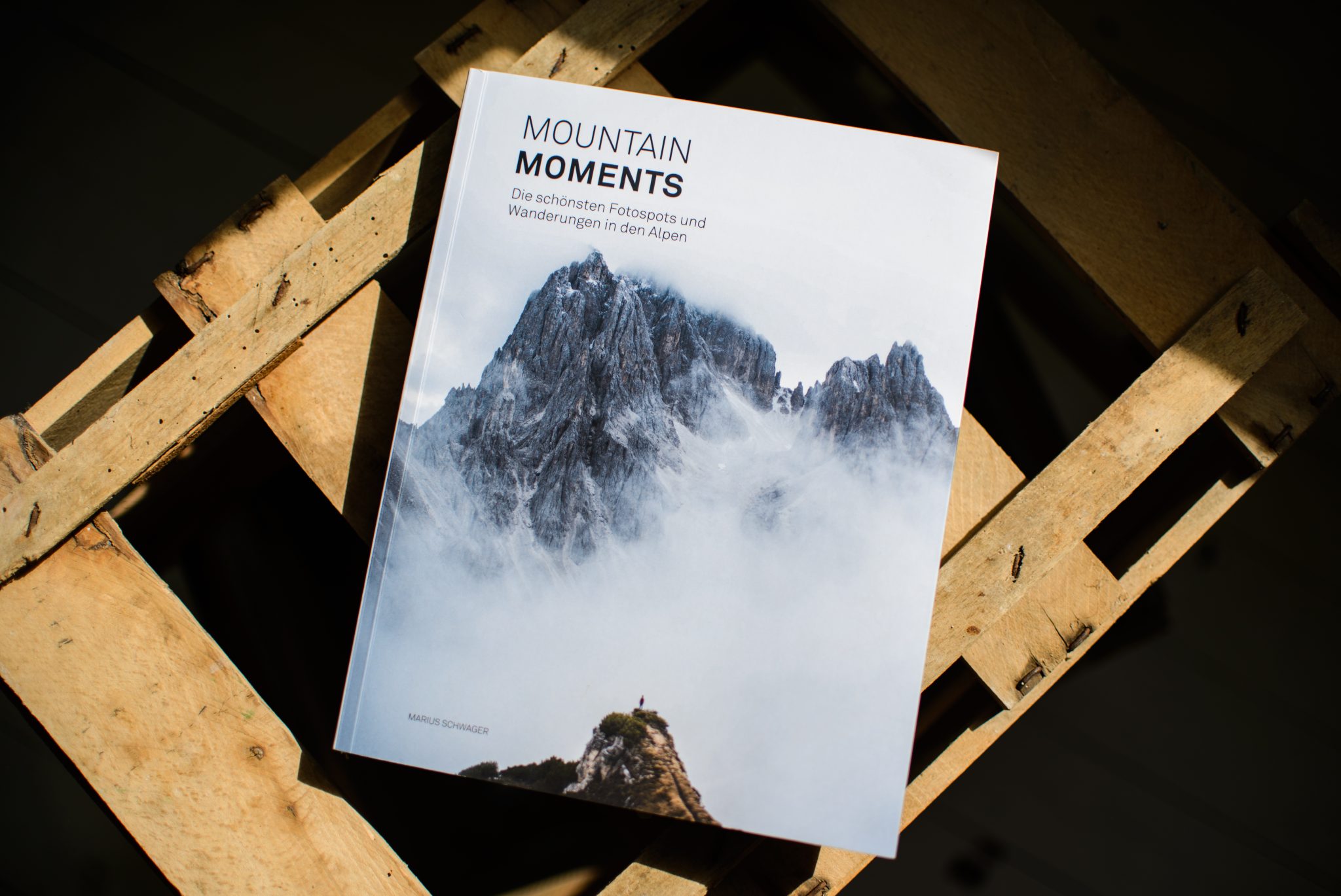A mountain book to dream about with the most beautiful photo spots and hikes in the Alps – From Neuschwanstein to Lake Bled in Slovenia. In the new Mountain Moments book by bestselling author, photographer and mountain lover Marius Schwager from Innsbruck, the reader is presented with 30 different routes in a visually appealing way.
Visual photo treats are combined with the most important information about the tour as well as a classification of the difficulty of the route in 5 levels.
But the book does much more. This gives you tips on photography and important information about hiking in the Alps.
We are pleased that the editor Marius Schwager was available for an interview shortly before the next trip to the Dolomites .
Dear Marius, when you hold your book in your hand for the first time, you immediately notice that great importance has been attached to aesthetics. The beauty of the images harmonizes with the clear layout, matching quotes and clear icons. Would you like to tell us a little bit about the development of the book? How do you approach such a project? Do you first determine the tours and then meet with the art directors or do you design in advance and then pick out the “suitable”?
Thank you very much for the compliment, the graphic designers/designers will also be happy. This was not my first book, but the first without an external publisher. The design or the freedom of design was also the main reason for his own project. The existing publishers often have fixed concepts and the design possibilities are correspondingly limited. A different paper, new concept, or unusual size are almost never feasible like this.
For your own book, of course, you need a basic idea of the processes and also the necessary capital to pre-finance the printing. Willingness to take risks, take on the uncertainty oneself and openness to problems that arise are probably the biggest obstacles.

The whole thing dragged on for about 2 years. First, Mathias and I developed the idea and then played through various concepts and tested something, got opinions and, of course, researched some tours.
After that, I looked for a designer and a cartographer at the same time, who were also willing to take a bit of a risk – and luckily I found them in Leon, Lacy and Conny. I trusted the employees to a large extent, “just let them do it”, and tried to have each team critically questioned. This is some effort, but it is worth it, because you can rethink some points and perhaps find new solutions. Our hiking maps, for example, manage the balancing act between being cartographically correct and at the same time blending harmoniously into the concept. And we can also offer the tours for download, so that you can leave the book at home and still have all the information on your smartphone.
In the foreword you mention that not only the factor “beauty” played a role in the selection of spots and hikes for the book, but also the popularity of the corresponding place. To what extent do you think “Insta-tourism” has arrived in the Alps?
Insta Tourism has definitely arrived in the Alps. If you see a picture online, you have the place directly in front of your nose via GPS coordinates in 2 clicks or via an image search. All you have to do is follow the arrow of your navigation system and get to any place. Basically, this is not a problem, only if places are not made or prepared for masses of visitors. In the Alps, there is a lot about the difficulty of the places to get there. Some places, on the other hand, have been tourist magnets for over 100 years and have already found regulations that work locally. For example, Zermatt, which can only be reached by train, car bans on Lago di Braies and the Alpe di Siusi, or a certain limited number of bus connections and car parking spaces in general.
Many places that I know and that are beautiful might not withstand the rapid development that is possible today, or there would be major problems for the residents. These are intentionally not in the book. The tour at the Schrecksee, for example, was such a borderline case. On the one hand beautiful and already quite well-known, on the other hand it is a very fragile ecosystem. In this case, I decided to take the tour because it is quite far there, and the parking lot at the starting point logically restricts access with it.
In general, I chose some spots because of their popularity, but also took an exciting variant hike that not only covers the “Insta-Spot”, but also allows contact with nature. For example, at Neuschwanstein Castle. If you walk the round, you will be stuck in the tourist hustle and bustle, but most of the time of the long hike you won’t meet very many people.
In your workshops, you attach great importance to sustainability and consideration for animals and nature. You also go into detail about the topic in the book. (How) do you think the behaviour of tourists in the mountains has changed in recent years and what measures would have to be taken to protect the environment?
Most people in our society have an ever-faster life and want quick solutions. At the same time, a kind of longing for nature and simple life and deceleration emerges as a contrast to this and can be seen, for example, in the greater popularity of the topic of hiking and photography. Both are very slow activities that place great emphasis on experiencing nature.
The vast majority of people do not consciously destroy nature, but simply do not think much about what their behavior does.
I think a lot can be achieved with better education. Not every city dweller or every local knows that you shouldn’t jump into a mountain lake smeared with sunscreen, as you might quickly destroy an ecosystem. In my opinion, a lot of positive things would be achieved with more education – e.g. in the form of small signs or software solutions. And especially for mountain sports, better public transport and easier booking and planning would be essential. At the moment, you almost always have to travel by car, so I think there is a lot of room for improvement.
If I want to travel to the Alps for hiking as a young family with two small children. Which hike from your book would you recommend to us?
That depends. Beginners, adults as well as children, should stick to the easy tours. If the kids are fit and can make decisions independently with risk (e.g. risk of falling), they can also tackle the more difficult hikes right away.
Is there a dream place in the Alps that you haven’t been able to explore yet?
This summer I want to go to the Slovenian Alps, where I haven’t really been active yet. The same applies to the other end of the Alps between Briancon and Turin.
Is a holiday in more southern climes an option for you as an alpinist? Or to put it another way: Is a white beach in the Seychelles an attractive motif for you?
A little relaxation rarely hurts, I think. After usually 2-3 days of relaxing, however, I quickly get bored and want to discover or try something or do sports. Seychelles, yes, but then please with diving, snorkeling, surfing or beach runs. Photographically, however, I prefer to stay in the mountains or for a change to something reportage-related with people.
You live in Innsbruck. What does the perfect day in Tyrol’s capital look like for you?
The perfect day for me is a spring day. He starts very early with an Italian coffee and healthy breakfast. It then goes quickly to the first cable car in the morning and 8 o’clock. The first tracks are made in the fresh deep snow as the remaining clouds disappear and the first rays of sunshine appear. Then a small climb to another untouched descent.
At noon, the skis are exchanged for the mountain bike. The last meters of altitude are walked to a summit, the sunset is enjoyed and, of course, photographed. With the mountain bike you go quickly back down into the valley in the headlight of the headlamp and the day ends with a glass of wine reviewing the pictures of the day.
To the editor

Marius Schwager is a social scientist and economist. When he is not leading photo workshops, he is usually on expeditions in the Alps and tries to capture atmospheric, natural images and the stories behind them. The adventures find their way into best-selling books, magazines and international customers from the outdoor industry. He prefers to share experiences with like-minded people and those willing to learn.
To Mountain Moments
Mountain Moments is a portal for photography and mountain experiences. On www.mountainmoments.de , mountain enthusiasts will find a lot of helpful information about mountain sports and mountain photography. In workshops, seminars and trips, nature lovers learn everything they need to know about photography and experience unique adventures in the mountains. The goal of Mountain Moments is to bring the beauty of the mountains and nature closer to alpine lovers all over the world. Mindful and sustainable behaviour is the means of choice to increase the enjoyment of nature and thus protect and preserve it at the same time. The new book “Mountain Moments – The Most Beautiful Photo Spots and Hikes in the Alps” is the latest medium of this project.
Information
Mountain Moments: The most beautiful photo spots and hikes in the Alps
Editor: Marius Schwager
1st edition 2020
ISBN: 978-3-948723-00-2
194 pages, 122 colour photos, 30 topographical hiking maps, 30 hikes, 95 photo spots, overview map, complete tour information, GPS coordinates (online)
Format 18*23 cm
Illustrated book quality
Price: 26,99 Euro (D)
Available at www.mountainmoments.de
Direct link: www.mountainmoments.de/alpen-die-schoensten-fotospots-wanderungen/


